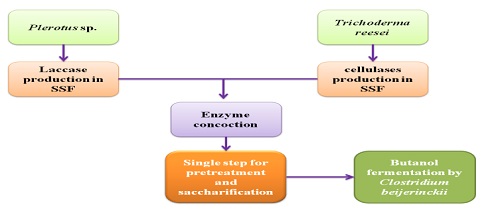
Sanjeev Kumar
Indian Institute of Technology, Kharagpur, India
Title: A challenging attempt towards utilization of non-edible lignocellulosics for cost-effective biobutanol production
Biography
Biography: Sanjeev Kumar
Abstract
Global raise in the living standards of the society throughout the world has created a huge demand for transportation fuel. Conventionally energy demand used to be met through the use of fossil fuels but due to environmental concerns, sustainable sources of fuels are being researched upon nowadays. In this venture, biofuels have gained immense popularity since they are carbon neutral and has the potential to fulfill the demand1. Nowadays pretreatment and saccharification of lignocellulosics is performed sequentially in order to obtain fermentable sugar for biofuels production2,3. In the present study, pretreatment and saccharification was investigated concomitantly to obtain reducing sugars from bamboo using laccase and cellulases extracted from solid state fermentation of Pleurotus sp. and Trichoderma reesei respectively. One of the main advantages of this process is the overall time reduction since pretreatment and saccharification is conducted simultaneously. Laccase assists in increasing cell wall permeability by degrading the lignin and thus facilitated the diffusion of enzymes into the cell wall to cause hydrolysis of holocellulose for the production of fermentable sugars. Process parameters governing the system viz., temperature, incubation time, pH, cellulase: laccase ratio in the enzyme cocktail and solid loading were optimized using response surface methodology thus producing a maximum reducing sugar content of 75.45 g/L. HPLC analysis revealed that broth has mixtures of glucose (36.89%), pentoses (24.29%) and cellobiose (38.81%). The potential of these sugars was analyzed using Clostridium beijerinckii by converting the sugar rich broth into butanol4. Clostridia have the capability to utilize C6, C5 and disaccharide sugars

Recent Publications:
- Procentese, A., Raganati, F., Olivieri, G., Russo, M.E., Marzocchella, A., 2017. Pre-treatment and enzymatic hydrolysis of lettuce residues as feedstock for bio-butanol production. Biomass Bioener. 96, 172–179.
- Ma, K., Ruan, Z., 2015. Production of a lignocellulolytic enzyme system for simultaneous bio-delignification and saccharification of corn stover employing co-culture of fungi. Bioresour. Technol. 175, 586–593.
- Dhiman, S.S., Haw, J., Kalyani, D., Kalia, V.C., Kang, Y.C., Lee, J., 2015. Simultaneous pretreatment and saccharification: green technology for enhanced sugar yields from biomass using a fungal consortium. Bioresour. Technol. 179, 50–57.
- Kumar, S., Gujjala, L.K.S., Banerjee, R., 2017. Simultaneous pretreatment and saccharification of bamboo for biobutanol production. Ind. Crops Prod. (Accepted)
- Al-Shorgani, N.K.N., Isa, M.H.M., Yusoff, W.M.W., Kalil, M.S., Hamid, A.A., 2016. Isolation of a Clostridium acetobutylicum strain and characterization of its fermentation performance on agricultural wastes. Renew. Energy, 86, 459–465.

